
“New” certificates keep appearing
Everyone I talk with agrees that the number of new certificate varieties should start tapering off. But when?
I remember a conversation with George LaBarre about 1993. We knew the number of North American railroads was unknown, but we thought the number probably exceed 15,000. Of those, we thought maybe a quarter would ultimately be represented by one or more certificates. Obviously, major companies like the B&O, C&O, N&W, L&N, New York Central and Penn would contribute huge numbers of varieties. Our overall guess was that 12,000, maybe 15,000, distinct varieties would ultimately appear.
After eleven years, we seem to have been amazingly close on the percentage of companies represented by certificates. However, we were substantially low on the total number of companies. Consequently, the number of distinct varieties has already passed 15,000. And, it doesn’t look like we’re slowing down much.
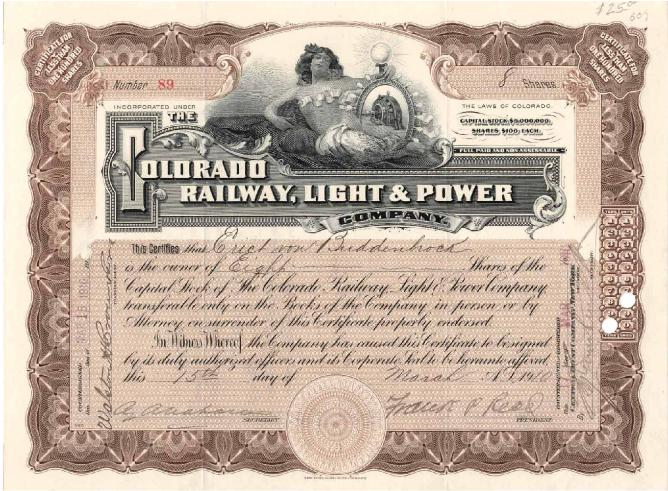 Seemingly rare certificate from the Colorado Light & Power Company, dated 1910. I stumbled onto this certificate about five years ago in a flea market a couple miles from home. So far, this is the only example I have encountered.
Seemingly rare certificate from the Colorado Light & Power Company, dated 1910. I stumbled onto this certificate about five years ago in a flea market a couple miles from home. So far, this is the only example I have encountered.
So, what’s going on?
From all the people who generously contribute to this effort, it appears many collectors are examining their collections more closely. Several catalogs (mine, Schabmayr’s, LaBarre’s, and Yachtman’s) are now in fairly widespread use among collectors. Collectors now have many descriptions and pictures to compare their collections against.
I find it exciting that almost every collector, no matter the size of their collection, has the capability of contributing new information to the hobby. It is really hard to contribute new information to the coin and stamp hobbies.
I think it also helps that collectors now have a way of both recording and examining serial numbers. The number of serial numbers in the database is already approaching 67,000. While that number is a mere drop in the bucket compared to the number possible, it is a sufficient number to expose many new varieties.
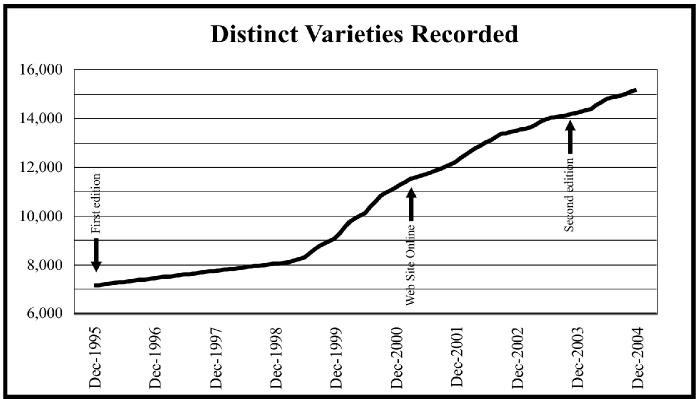
Another major thing happened that I, for one, never anticipated — the web. With such a tremendous increase in the ability to communicate, collectors can now contribute information in seconds that used to take days and weeks.
With the web came eBay, online commerce, and the ability to freely participate in live auctions far outside collectors’ normal borders and experiences. I guess the majority of new discoveries has always originated from auctions. High-ticket, high-rarity items remain the mainstay of professional live auctions (Smythe, Winslow, Holabird, Boone, FHW, HWPH, Tschoepe, etc.) Such auctions attract high-powered, experienced collectors and dealers. Those auctions have historically contributed almost all of the information about super-rarities.
If there was ever a problem, it was finding reliable information about middling material. Without the tremendous collector contributions that come to me through the web, I would have found it almost impossible to find photos and good information about scarce, but not rare, certificates.
That is where eBay has proven a wonderful source. Collectors like myself, with modest check books, can now find, and actually compete in buying certificates that would expensive for major auction houses to list and sell. (Major auction houses can’t make money producing expensive catalogs to sell $10 to $75 items.)
I don’t have reliable proof, but it seems like the number of new discoveries coming from major auction house catalogs has stayed fairly constant over the last ten years. However, the number of new discoveries coming from online auctions has blossomed dramatically.
The 900-pound gorilla is eBay, which started business in 1995. Counting all of eBay (including the U.S., Canadian, German, and British sites), it appears that people list around 200 to 300 North American railroad certificates each day. Of that number, collectors find and contribute information for an astounding 5 to 10 completely new certificates every week. You can see the result of their contributions in the graph at left.
So, when are new discoveries going to taper off? The overall pace of new varieties seems to be slowing slightly. Still, I am currently guessing that the next two years will disclose an additional 1,500 varieties. Of course, I’ve been wrong before and I don’t plan to change that shortcoming. Let’s grab another 1,000 varieties, and I’ll re-examine my opinion.
Census — 237 new varieties since September
|
September
letter |
This
letter |
| Number of certificates listed (counting all variants of issued, specimens, etc.) |
19,646 |
19,975 |
| Number of distinct certificates known |
14,965 |
15,202 |
| Number of certificates with celebrity autographs |
1,474 |
1,489 |
| Number of celebrity autographs known |
323 |
325 |
| Number of railroads and railroad-related companies known |
24,953 |
25,021 |
| Number of companies for which at least one certificate is known |
6,445 |
6,508 |
| Serial numbers recorded |
65,096 |
66,662 |
Who was Henry Oppenheimer?
Over the years, I have encountered several dealers’ lists offering B&O stocks with this man’s signature. The implication has always been that his signature somehow enhances the value of otherwise ordinary certificates.

Henry Oppenheimer autograph, 1899, courtesy of William Knadler.
Admittedly, “Oppenheimer” is a famous name with connections to atomic research, diamonds, and a modern brockerage. But so far, neither Scott Winslow nor I have been able to locate even one reliable reference to this individual! (I asked other dealers for input, but only Scott replied before I wrote this newsletter.)
Oppenheimer signed many B&O certificates between 1898 and 1900, so he obviously controlled significant wealth. Yet, why is he so elusive?
Collecting Software
Collectors occasionally ask for recommendations of good collecting software.
Do you have recommendations that I can pass on? Or maybe you’ve found software you would rather avoid. Please contact me with your experiences.
An excellent Harriman book
I recently read Maury Klein’s last book, The Life and Legend of E.H. Harriman. Along with Gould (another terrific Klein book), Vanderbilt, Morgan, and Hill, Harriman was one of the most influential driving forces of American railroading. This is the best non-fiction book I have read in a long, long time and I wholeheartedly recommend this book.
Thanks for the images!
A special thanks to everyone who sent images of certificates this past year. During calendar year 2004, collectors and contributors sent 5,442 scans and digital photos. Of that number, collectors sent approximately 2,262 high-resolution scans. (Actually, this number is larger, but I still have three CDs worth of images I have not had time to catalog yet!)
Many new specimens appeared in 2004
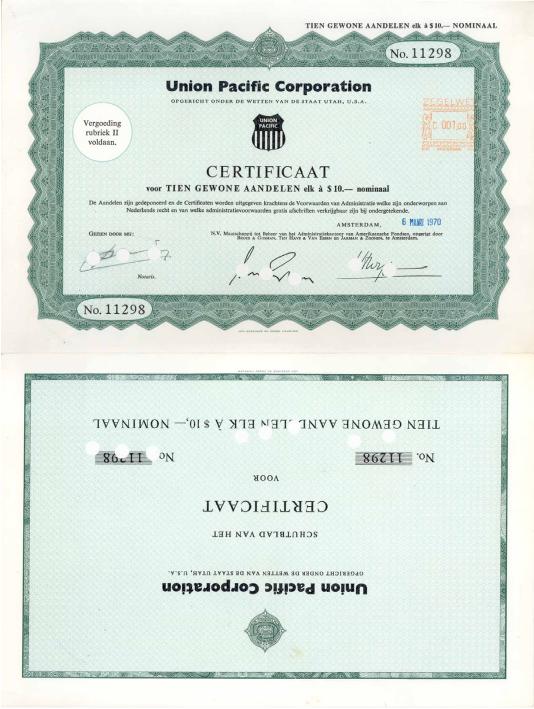
A 1970 Dutch certificate for ten shares of the Union Pacific Corporation printed on only one side and meant to be folded in half. The ornate Victorian-style logo at the top of each page says “BGA” which seems to stand for Broes & Gosman, Administratienkantoor. Certificate courtesy of Colin Bruce II.
A substantial number of new varieties originated this past year from a small flood of completely new specimens. If you avoid collecting specimens (and some people do), then you have missed some terrifically rare and otherwise unattainable certificates.
Specimens are identical in all respects to issued certificates, except that they were usually numbered “00000” and were unsigned. Generally, specimens are known in quantities of only 1 to 3 examples. I only know of a few with as many as 25 examples.
I am not here to try to drive up prices. But I do feel a responsibility to point out that the current census shows 13% of all railroad certificates are known only from specimens. Avoid specimens and you will miss some of the rarest items you might ever have in your collection.
What is your opinion on selling coupons?
In the last year, I have encountered an increasing number of online auctions where people are trying to sell coupons. Some sales are for singles. Some for full sheets. But, not a week goes by without someone contacting me about coupons.
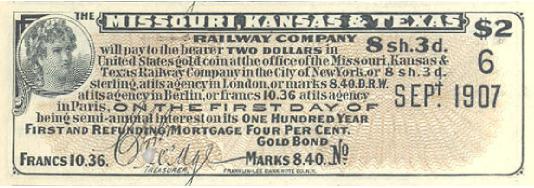
Much of the time, they tell me they found their coupons in a safe box or an attic. Generally, they come to me with the mistaken impression that their coupons are “bonds.” Curiously, I’ve seen verbiage in online auctions implying the same thing.
Every inquiry seems to involve discovering whether their coupons have lingering security value. I steer them to people more knowledgeable than myself on that issue, but each time I do, I become more and more concerned about the potential impact on our hobby.

It is one thing if these people really do discover coupons, somehow without matching bonds, in an ancestor’s safe box. It’s an entirely different matter if these are beginning collectors, new to our hobby, who just bought a worthless coupon under the impression that it was somehow collectible.
My opinion is simple. I do not think we should be assigning values to coupons separate from bonds. I think we should fight this trend tooth and nail. I think we should strongly discourage the development of any market in single coupons. I am deeply worried that this will establish a trend of clipping coupons from collectible bonds, selling them individually, and ultimately destroying, or drastically lowering, the value of ordinary bonds. Again, in my opinion, I see selling individual coupons as a slippery slope we should avoid like the plague.
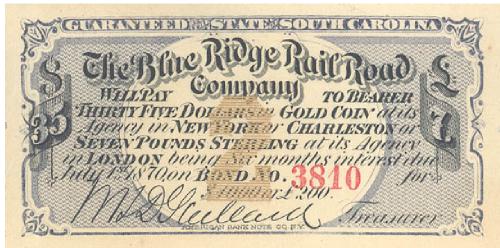
Maybe you have a different opinion. Maybe you don’t see the problem as pessimistically as I do. Maybe I am over-reacting. If so, tell me. I am willing to listen to arguments to the contrary. I don’t claim to be right. I merely claim to be worried.
If you have any opinion on this subject, pro or con, please write or email.